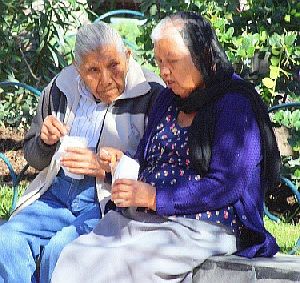Few contrasts between American and Mexican cultures are more striking than the way in which each views and treats its senior citizens.
America’s seniors are often cloistered in assisted living facilities or nursing homes far from family and friends while Mexico’s oldest, los ancianos, seem more often vibrant and interactive - notably present in its public life. This is especially apparent in its villages.
It’s hard not to see the paradox in these contrasts. The nation with a far superior capacity to maintain its seniors’ quality of life, and which has taken great pains to make transportation and public use facilities accessible to its disabled, has also segregated its seniors from the social mainstream on a wide scale.
The paradox is a reflection of the two nations’ cultural perspectives. In Mexico, "family" trumps "generation gap." Mexicans are far more likely to respect and cherish their oldest generation and revere it for its wisdom and life experience.
Many among the current crop of los ancianos are the children of those who participated in the century-old Mexican Revolution. They’ve witnessed and lived history as it’s unfolded through the greatest social transformation in the nation’s history.
The American media’s fixation on youth marginalizes its oldest save for the rich, powerful, or otherwise famous. The result is that America’s aged seem more often perceived by their offspring as an unpleasant reminder that they, too, will in due time grow unfashionably old and less socially relevant.
 |
Particularly in Mexican village life, los ancianos remain connected to lifetime friends and many live within their extended families. There’s a lot to suggest that this lifelong connectedness affords them greater comfort in their advanced age.
Americans move further and more often from their place of birth than do those living in any other first world nation, with the result that they more often live far away from their oldest relatives. Affordable senior care facilities make it easier for American families to live separately from their aged relatives.
Maybe there’s also something to be said for lifestyle when it comes to keeping Mexico’s ancianos animated and mobile. Economic necessity and a thinly stretched social safety net keep many Mexicans working into advanced age, but the work seems to leave many no worse for wear and sometimes even to hold disability at bay.
A lifetime of meals simply and sparingly prepared has left many lean and wiry. It’s not unusual to see these ancianos navigate dauntingly high curbs and cobblestone streets to remain a daily village presence on its sidewalks, in its public spaces, and at public events.
In the end, though, nothing can better capture the special place that Mexico’s ancianos occupy in its social fabric than their images.


